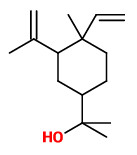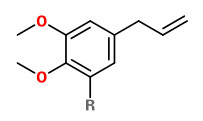Canarium luzonicum (Blume) A. Gray - syn. Pimela luzonica Blume - Burseraceae - elemi, manila elemi, Manilaelemi
Tree, up to 35m high, native to the Philippines, common in primary forests at low and medium altitudes.
http://www.biodiversitylibrary.org/page/40228553#page/634/mode/1up
„The tree secretes a soft white resin called Phillipine elemi, from which is borne out in the air and used as incense.“
http://de.wikipedia.org/wiki/Canarium_luzonicum
„Aromatic elemi oil is steam distilled from the resin. It is a fragrant resin with a sharp pine and lemon-like scent… Elemi resin is chiefly used commercially in varnishes and lacquers, and certain printing inks. It is used as a herbal medicine to treat bronchitis, catarrh, extreme coughing, mature skin, scars, stress, and wounds.“
http://en.wikipedia.org/wiki/Canarium_luzonicum
Extraction of the oleoresin using volatile solvents produces a resinoid with the olfactive description 'Aromatic, fresh, woody, resinous'.
http://matieres-premieres.robertet.com/elemi-resinoid
Steam distillation of the resinoid yields elemi oil with olfactive description 'Spicy, peppery, zesty, sparkling'.
http://matieres-premieres.robertet.com/elemi-oil
„Elemi oil is responsible for the fresh-lemony, peppery odor of crude elemi and of elemi resinoid. The main constituent of the oil is phellandrene, a very unstable terpene, widely distributed in the plant kingdom. Small amounts of high-boiling, oxygenated components lend character and interesting dry-out notes to this oil which is found in amounts of 25-28% in elemi.
[Arctander, Steffen. Perfume and flavor materials of natural origin. 1960, 185; reprint Arctander, Steffen. Perfume and flavor materials of natural origin. Lulu. com, 2017, 144-145 (orig.221-223)]
„Elemi gum is collected from several species but mainly Canarium luzonicum (Micu)A.Gray (syn.C.commune Wild.) in Malaysia and the Philippines.
[Robin Clery „Fragrant adventures in Madagascar“, in: Swift, Karl AD, ed. Advances in flavours and fragrances: From the sensation to the synthesis. Royal Society of Chemistry, 2007, 92-98]
Manila elemi resin is constituted of tetra- and pentacyclic triterpenoids (70-80%) and essential oil (20-30%). An extract of the resin contained monoterpenes (30.8%) and sesquiterpenes (0.4%). Main monoterpenes were limonene (23.5%), α-phellandrene (4.2%), sabinene (0.7%), and γ-terpinene (0.5%). Main sesquiterpenes were elemol, β-eudesmol, and guaiol.
[Brieskorn, Carl Heinz, and Georg Krauß. „Monoterpene, Sesquiterpene und dimere Phellandrene aus Manila-Elemi.“ Planta medica 52.04 (1986): 305-307]
The essential oil of manila elemi contained limonene (54-56%), α-phellandrene (8-17%), elemol (6-13%), sabinene (3-5%), elemicin (2-4%), β-phellandrene (2%), α-terpinolene (2%), and α-terpineol (1-2%).
[Gael, Kemal Hiisnii Can Bogart Temel, and Mine Kiirkeiioglu. „The composition of Manila elemi oil.“ Flavour and fragrance journal 8 (1993): 35-37]
„Manila elemi oil, hydrodistilled from Manila elemi gum, was analysed by GC and GC-MS. Thirty-nine compounds constituting together 99.2% of the oil were identified, limonene being the most abundant (56%)… The other main components identified were α-phellandrene (17.6%), elemol (6.3%), sabinene (5.7%), α-terpinolene (2.8%), elemicin (2.4%), and β-phellandrene (2.3%). An interesting feature of this oil is the occurence of phellandrene dimers.
… oil kept in a colorless container …showed some significant changes. The relative percentages of limonene remained more or less the same… While the relative amounts of α-phellandrene and sabinene decreased almost by half, there was an approximately two-fold increase in the percentage amounts of elemol, elemicin, α-terpinolene and a number of minor compounds such as α-phellandrene dimer.“
[The composition of Manila elemi oil, Merle A. Villanueva, Rosalinda C. Torres, Kemal Hüsnü Can Başer, Temel Özek, Mine Kürkçüoǧlu, Flavour and Fragrance Journal, Vol.8(1), 2006, 35 - 37]





